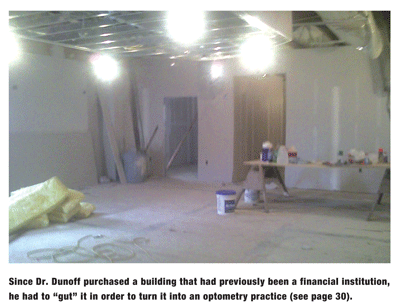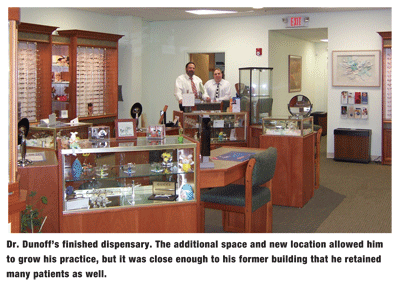Suburban
Dr. Massie knew what he had to do. Still, the prospect of actually moving to a new location was far from an easy choice. It was the biggest decision that I have ever had to make, Dr. Massie says. I was concerned that I would lose patients.
Dr. Massie can now breathe a sigh of relief. He moved just a few months ago, and the move was a success, thanks to careful planning every step of the way. Dr. Massie even drew up a calculated relocation checklist that included such items as hiring IT consultants to help him add 11 more computers, creating a strategic marketing plan and meeting with local officials about signage.
Today, Dr. Massie says he could not be happier. Through hard work and planning, Dr. Massie was able to triple the size of his practice at his new location, and he was able to retain his patient base. With 5,500 square feet to work with, he was able to add some dream perks, including a putting green and fireplace in the reception area and a skybox with leather furniture and a flat screen TV in the second waiting area, so patients can relax while dilating or wait for their families to pick them up.
It wasnt easy, but the results paid off. Like Dr. Massie, most O.D.s who have relocated a practice will probably tell you that you can never plan too much when making a move.
Step 1: Think It Over
If you are actively considering making a move, think it out carefully beforehand.
One of the key reasons optometrists decide it is time to move: space or lack thereof. We have some pretty good stats from client files that support that the last frontier for profitability is space, says optometrist Gary Gerber, president of The Power Practice. For example, assuming a practice does absolutely everything correct, the last barrier to expansion is the physical size of the office. We see that barrier as about 1,000 per square foot of space. So, theoretically, a 1,000-square-foot office will max out at $1 million in sales and cant do another dollar more without adding more space.
When making the big decision to move, Dr. Gerber also recommends that you ask yourself, Does it really solve the problems that are causing you to move in the first place? For example: Is there better patient flow, better access to your target demographic and more focused and manageable competition?
Whatever the reason for the move, think it out carefully beforehand. Make sure the move will enhance your practice. Whether its the ability to see more patients, add more instruments and services or add more staff or doctors, you want to have a good reason to go through all of this, Dr. Diecidue says.
Step 2: Location, Location, Location
Optometrist Lance Dunoff had been thinking about moving his
Once the decision was made, Dr. Dunoff scanned the local real estate market and contacted real estate agents to help him find the larger space that would still be close enough to his existing practice for the convenience of his patients. He searched for six months and finally found a location just two miles away from his previous practice.
Most O.D.s wonder whether or not their patients will follow them to a new location. Rather than just wonder or guess, Dr. Gerber recommends you simply ask your patients. For example, devise a survey or online questionnaire that says, Were thinking of moving our practice to X. If we did, how likely are to you to follow us? Dr. Gerber says most studies hes read point to a 15-minute drive as being the tipping point.
After Dr. Massie decided to move, he constantly drove around to see what property was for sale in the nearby vicinity. He did research beforehand, including analyzing the demographics of his patients. He looked for 18 months until he found a site 2.5 miles from his previous location that was closer to growth and migration and was along a main thoroughfare that had approximately 30,000 cars driving by it each day.
Step 3: Buy or Lease? Making It Pretty
Once youve settled on the ideal location for your new practice, Dr. Gerber encourages O.D.s to buy (not rent) whenever possible. Your building will be a part of your retirement, and you cant throw yourself out of your own building, he says. Also, he adds, you can expand more easily if necessary.
Of course, whether you decide to buy or lease, cost is often the major issue. Keep in mind, if its a great location and a great piece of real estate, most likely, it wont come cheap. Like most real estate, its safe to say that if its a good space, youll overpay for it, Dr. Gerber says.

Once youve found the ideal location and figured out whether buying or leasing is the right choice for you, then comes the design plan of the building and what goes inside, whether thats new equipment, an eye-catching dispensary or even the color of the light switches.
Since Dr. Dunoff bought a previous financial company, he knew he would have to gut the building. For him, finding a good general contractor was paramount to transform his new 6,000-square-foot building into a space that allowed him to see more patients and have better patient flow. He also hired Fashion Optical to help him add visual appeal.
Better patient flow was also of paramount importance when Dr. Massie overhauled his new building. In addition to removing internal walls for better patient flow, he also had to cut a trench in the floor for the in-house lab. It was quite a project, Dr. Massie says.
Any O.D. who has relocated a practice will advise you not to forget about the extra details that may not seem obvious at first. Transferring the phone, fax and notifying all of our vendors and third-party payers was another challenge that took time. There werent any big surprises for us, but I had to start thinking of things I never thought of beforelike making sure we had a snow-plow guy to keep our parking lot clear, and who was going to shovel the sidewalks, Dr. Diecidue says. Trash removal, heating and A/C costs, and others were another aspect of owning your own building that really didnt hit home until I started getting those bills.
While making the transition, make sure that its business as usual in your existing practice. This is no small task when planning a major relocation. Dr. Massie admits that the biggest challenge was finding time to make decisions. I am lucky that I had an associate, because I could only see patients twice a week for a six- month period during the move, Dr. Massie says.
Adds Dr. Dunoff: Planning is important. You cant do it on the fly, and you cant plan between patients.
Step 4: Marketing Is a Must
Letting your patients know about the move beforehand is critical in your relocation plan. Dr. Dunoff put signs up in his practice two months before the actual move; they explained to his patients that he was moving and that they would have even better care at his new location. In addition, he sent out a patient mailing about the move, which included a map, and he included the news in his newsletter.

In addition to setting up an easel announcing the move in his practice two months prior, Dr. Massie included the news in three consecutive issues of his practices newsletter. He also recorded an automated announcement that every patient received by phone. And, he sent a letter and a map right before the move and issued a press release to the local paper.
Dr. Diecidue told each patient personally about his upcoming relocation and when to expect it. He also took out ads in his local paper, and he posted it on his practices Web site. We sent a letter to every single patient shortly before the date, and every recall card from about three months prior to more than a year after the move had a bright orange sticker informing them of the new address, he says. And, even after all that, some patients still didnt find us for three or four years.
Despite the savviest of marketing efforts, a few patients undoubtedly will slip through the cracks when finding out about a move and, of course, a few may decide not to follow the O.D. to the new location.
Dr. Gerber suggests using an assumptive close sales strategy in retaining current patients. For example, instead of saying to patients, Please come and visit us in our new office, Dr. Gerber recommends you say, Your records are waiting for you in our office. Doctors should assume there will be a continuance of care and put that wording in their marketing message, he says.
Step 5: Time to Go: Limiting Down Days
A seamless transition and limiting down days between closing your old practice and opening your new one is also a critical step in your new practices success. You can achieve this by following a step-by-step process and planning carefully ahead of time. With planning, and lots of it, Dr. Gerber has been able to move clients over a weekend.
Dr. Diecidues moving schedule: We closed early on a Friday (by noon), moved all the equipment and fixtures over that night and spent the rest of the weekend setting everything up, he says. Prior to that, we had frame displays and some office equipment delivered and set up.
Getting the staff on board to pack boxes instead of their usual job description duties was a challenge, but once they were committed to the project, Dr. Dunoff was able to close for only one week. We took two days to move, and the rest of the week, we just put things away, he says.
Step 6: Officially Open For Business
With a step-by-step plan, relocating a business will have its challenges; but in the end, the rewards should be worth it for both you and your patients. You can never plan too much, Dr. Diecidue says. Take the time to go over every aspect of your move and make sure you have a contingency plan if one way doesnt work, so that you can be open for business on the day you plan.
Dr. Diecidue moved six years ago and, looking back on his step-by-step plan, he says he would not have done anything differently. The move was a blessing for us, he says. We are now able to provide more services to our patients and have room to spare. We are currently expanding our office space into a second floorsomething I had planned for when I built the buildingto give us even more flexibility.

